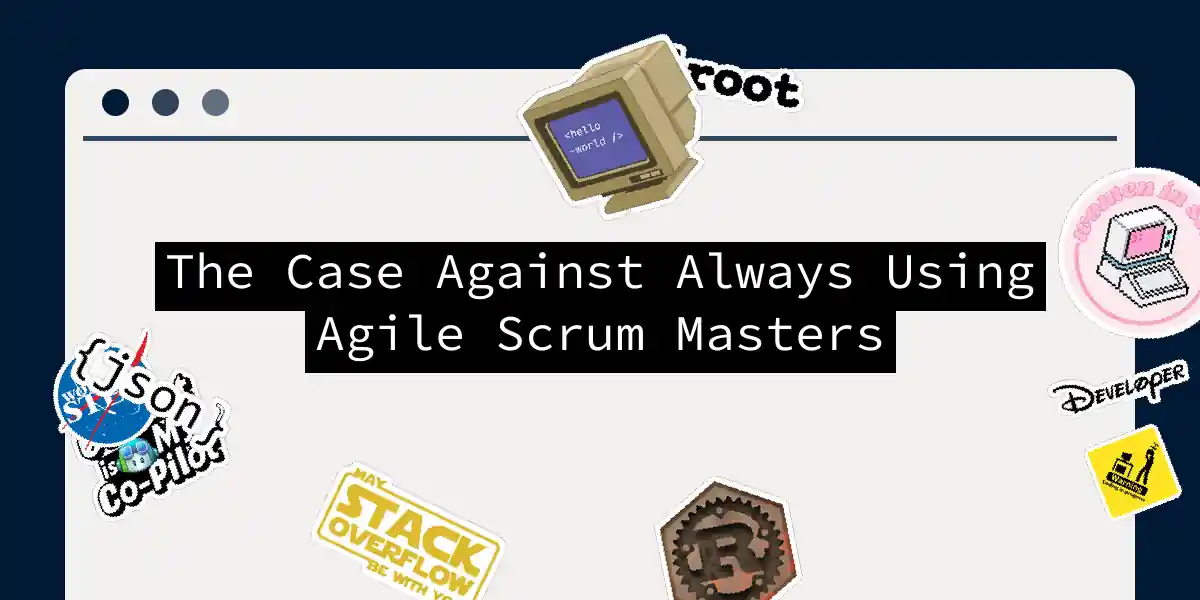The Agile Dilemma: When Scrum Masters Become More Hurdle Than Help
In the ever-evolving landscape of software development, Agile methodologies, particularly Scrum, have become the de facto standard for many teams. However, beneath the surface of this seemingly efficient and collaborative approach lies a complex web of challenges and pitfalls. As someone who has navigated the trenches of Agile development, I’m here to make the case against always using Agile Scrum Masters, and why this role might not be the silver bullet it’s often touted to be.
The Role of the Scrum Master: A Double-Edged Sword
At its core, the Scrum Master is supposed to be the facilitator, the guardian of the Scrum process, and the remover of obstacles. But in practice, this role can often become a bottleneck rather than a catalyst.
Lack of Objectivity and Time Constraints
One of the most significant issues with having a developer double as a Scrum Master is the lack of objectivity and the time constraints that come with it. A developer who is also the Scrum Master may find it challenging to maintain the necessary distance during code reviews, leading to biased feedback and overlooked critical issues[5].
Moreover, fulfilling both roles simultaneously is a Herculean task. The responsibilities of a Scrum Master are extensive and require full-time attention. Combining this with the demands of software development means that one or both roles will suffer. It’s akin to trying to juggle too many balls at once; eventually, some will drop.
The Misguided Focus on Short-Term Goals
Agile methodologies, especially Scrum, are often criticized for their focus on short-term business value at the expense of long-term technical excellence. This approach can lead to a culture where developers are incentivized to work on atomized, feature-level “user stories” rather than meaningful, long-term projects. The result is a pileup of technical debt and a lack of innovation in architecture and R&D[2].
The Anxiety of Sprints and the Illusion of Productivity
Scrum’s two-week sprints can induce a sense of constant anxiety and pressure to deliver. This environment often leads developers to cut corners to meet sprint goals, resulting in subpar code quality. The metrics used to measure productivity can be misleading, equating a hastily implemented feature with a well-architected one[3].
The Problem of Cross-Functional Teams and Scaling
When scaling Agile to larger teams, frameworks like SAFe (Scaled Agile Framework) are often employed. However, these frameworks can complicate the process further by introducing more layers of bureaucracy and misaligned roles. For instance, SAFe’s approach to scaling can lead to a situation where Scrum Masters are shared across multiple teams, diluting their effectiveness and creating a self-reinforcing loop of inefficiency[4].
The Impact on Team Dynamics and Career Growth
Agile methodologies, particularly Scrum, can disrupt team dynamics by encouraging individual efficiency over team collaboration. Developers might focus on completing their own tasks quickly rather than contributing to the overall team’s success. This can lead to a lack of cross-pollination of ideas and a diminished sense of teamwork[3].
Moreover, the atomized nature of user stories can hinder career growth for developers. By age 30, developers are expected to work at the whole-project level and beyond, but Agile’s focus on short-term goals can prevent them from gaining the necessary experience and skills[2].
Conclusion: A Balanced Approach
While Agile and Scrum have their benefits, such as increased flexibility and rapid feedback, they are not a one-size-fits-all solution. The role of the Scrum Master, in particular, needs careful consideration. Here are a few takeaways:
- Clear Role Definitions: If a developer is to act as a Scrum Master, there must be clear role definitions and a commitment to avoiding conflicts of interest.
- Focus on Technical Excellence: Organizations should balance short-term business goals with long-term technical excellence to avoid accumulating technical debt.
- Flexible Methodologies: Be open to adapting or combining different methodologies to suit the team’s needs rather than rigidly adhering to one framework.
- Team Health: Monitor team dynamics and ensure that the process is not undermining collaboration and career growth.
In the end, the key to successful software development is not about blindly following a methodology but about finding a balance that works for your team. So, the next time you’re tempted to implement Scrum or any other Agile framework, remember: it’s not just about the process; it’s about the people and the product.
Let’s make software development a journey of collaboration, innovation, and continuous improvement, rather than a rigid adherence to a set of rules. After all, as the saying goes, “the best way to predict the future is to invent it.” Let’s invent a future where our processes serve us, not the other way around.
